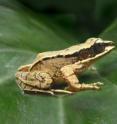Ultrasonic frogs can tune their ears to different frequencies
Researchers have discovered that a frog that lives near noisy springs in central China can tune its ears to different sound frequencies, much like the tuner on a radio can shift from one frequency to another. It is the only known example of an animal that can actively select what frequencies it hears, the researchers say. The findings, from a collaborative effort led by the University of Illinois and the University of California at Los Angeles, appear this week in Proceedings of the National Academy of Sciences. The research team also included scientists from the Chinese Academy of Sciences and the Massachusetts Eye and Ear Infirmary (at Harvard Medical School).
The discovery was made when researchers examined the eardrums of an unusual frog, Odorrana tormota, which communicates by making birdlike calls in the audible and ultrasonic frequency ranges. Previous research by two of the authors showed that the frog produces and responds to ultrasonic calls. In the new study they sought to determine whether the frog's eardrums actually vibrate in response to these ultra high frequency sounds.
Using a laser vibrometer to measure the eardrum's vibration, the researchers found that the eardrum did respond to sounds in the sonic and ultrasonic ranges. But they also saw something they couldn't explain: The eardrum's sensitivity to ultrasound sometimes disappeared altogether.
Normally sound waves strike the eardrum and – if they are powerful enough and in a frequency range that the animal can perceive – cause the eardrum to vibrate. In most studies of frogs, the eardrum responds exactly the same way to the same sound stimulus. Even the eardrums of a dead frog will respond with unchanging predictability.
Past research showed that a frog's eardrum never responds differently to the same sound stimulus, said team leader Albert Feng, a professor of molecular and integrative physiology at Illinois.
"This was contrary to everything that we knew about its auditory system," he said.
O. tormota, the concave-eared torrent frog, is unusual in other ways. Most frogs have ears on the body surface, but the torrent frog's ears are recessed. Feng and his colleagues previously reported that O. tormota communicates in a noisy environment by emitting high frequency calls that include ultrasonic sounds, and can localize sound with astonishing precision. Upon hearing a female call, a male will leap directly toward the sound with an error of less than 1 percent, a feat previously unheard of in frogs.
Fortunately for the researchers, the eardrum of O. tormota is transparent, offering a view of its inner workings in a living frog.
While puzzling over the peculiar results of the eardrum vibration measurements, the researchers noticed the sudden appearance and disappearance of a dark shadow on the eardrum, Feng said.
Further investigation revealed that the frogs were actively opening and closing their Eustachian tubes, the two narrow channels that connect either side of the pharynx to the left and right middle ear. The changing state of the Eustachian tubes was more readily observed by directing a light beam at the mouth from under the frog's chin. When the Eustachian tubes were open, the light was visible through the eardrum. When they closed, the circles of light glowing out through the ears disappeared.
"We said, 'Whoa! This is bizarre!' " Feng recalled. "In all textbooks on sound communication and hearing in frogs, it is plainly stated that the Eustachian tubes are permanently open!"
Feng and his colleagues had observed that when open, the Eustachian tubes essentially couple the frog's left and right ears. This "acoustic coupling" between the ears makes them sensitive to sound direction, enabling the frog to localize sound, Feng said.
To determine the consequence of active closure of the Eustachian tubes, the researchers measured how the open and closed Eustachian tubes affected the vibration of the eardrum.
They found that the frogs' eardrums became very sensitive to high frequency and ultrasounds when their Eustachian tubes were closed, compared with when they were open. When the Eustachian tubes were open, the eardrums responded mostly to low frequency sounds.
The frogs appear to be able to tune in to specific sound frequencies at will, Feng said. They can shift to high frequency and ultrasonic hearing when the low frequency background noise of rushing water is too intense for them to pick out the calls of potential mates or rivals, he said.
This research likely has implications for human health. Earlier research into the mechanics of frog hearing helped Feng and his colleagues at the U. of I.'s Beckman Institute for Advanced Science and Technology design an "intelligent hearing aid" that boosts sound signals of interest.
Source: University of Illinois at Urbana-Champaign
Other sources
- 'Bizarre!' Frog Tunes Ears to Specific Frequenciesfrom Live ScienceTue, 22 Jul 2008, 20:42:18 UTC
- Ultrasonic Frogs Tune Their Ears to Different Frequenciesfrom Live ScienceTue, 22 Jul 2008, 15:28:25 UTC
- Ultrasonic Frogs Can Tune Their Ears To Different Frequenciesfrom Science DailyTue, 22 Jul 2008, 14:21:10 UTC
- Ultrasonic frogs can tune their ears to different frequenciesfrom Science BlogTue, 22 Jul 2008, 14:14:03 UTC
- Ultrasonic frogs can tune their ears to different frequenciesfrom PhysorgTue, 22 Jul 2008, 13:56:06 UTC
